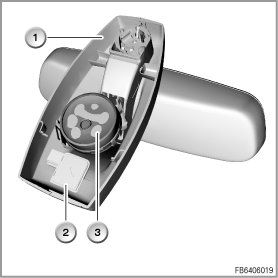
The rain/light solar sensor groups the following sensors and components into one control unit:
The rain/light solar sensor is inserted from the inside of the windscreen in the wiper range of the windscreen wiper. The rain/light solar sensor is fixed in the bracket by a steel-plate spring. The holder is firmly bonded to the windscreen. There is a gel pad between the rain/light solar sensor and the windscreen. The gel pad is fitted on the optical element (new component). It provides the optical connection to the windscreen and prevents dirt from entering.
NB: after installation of a new rain/light solar sensor, the gel pad can no longer be removed without damage, rather it is destroyed.

Index |
Explanation |
Index |
Explanation |
|---|---|---|---|
1 |
Mirror base covering cap |
2 |
Condensation sensor |
3 |
Rain/light solar sensor |
|
|
This installation location ensures that the windscreen surface in the area of the sensor remains free of dirt and ice. To prevent the sensor surface from fogging over, the sensor is heated.
The rain/light solar sensor is supplied with voltage from the roof function centre. The signals of the rain/light solar sensor are transferred through the data buses.
The rain sensor is an optical sensor. It consists of an optical element. An electronic module is also integrated. Alongside the electronic evaluation unit, 3 optical transmitter and receiver diodes are integrated in the electronic module.
The driving light sensor is also an optical sensor. It consists of 2 photo diodes and the corresponding electronic evaluation unit. One photo diode is aligned forwards and it picks up the light that strikes the front (frontal light). The second diode is aligned upwards and it picks up the light striking from above (ambient light).
The solar sensor consists of two photo diodes. These diodes are fitted on the right and left on the sensor field of the rain/light solar sensor.
The electronic module evaluates the individual sensor signals and communicates with the roof function centre.
The following system functions are described for the rain/light solar sensor:
Operating button on the wiper switch activates the rain sensor. When the rain sensor is active, the function LED on the wiper switch lights up in green.
First of all, one wipe cycle is run as visual feedback of the switching on. Then, the 3 transmit diodes emit infrared light that is routed via the optical element to the windscreen. If the windscreen is completely dry and clean, the infrared light is fully reflected to the 3 receiver diodes.
If there is water or dirt in the area of the optical element on the windscreen, the infrared light is refracted. This means that only part of the infrared light is reflected to the receiver diodes. The amount of reflected light is thus the measurement of the intensity of the precipitation in the area of the optical element. The electronic evaluation unit uses the missing amount of light to detect the degree of wetness on the windscreen. It sends a signal across the data bus. On the basis of this signal, it is assessed in the junction box electronics whether a wipe cycle is necessary.
The sensitivity of the rain sensor can be varied in 4 stages by means of a knurled wheel on the wiper/washer switch. Each operation of the knurled wheel towards ”Increase sensitivity” (i.e. turning the knurled wheel upwards) runs a wipe cycle.
With the vehicle stationary and failure of the rain/light solar sensor, the windscreen wiper is switched into a fixed intermittent operation mode. On switching off terminal R, the rain sensor is switched off for safety reasons.
The change in lighting conditions in front of the vehicle and in the environment of the vehicle is picked up by the light-sensitive sensors. The lighting condition is processed by the electronic evaluation unit and sent across the data bus to the footwell module. Depending on the brightness, with the Automatic Light Control active, the low-beam headlight is switched on and off.
The solar sensors measure the intensity of the sunlight separately for the driver's and passenger's side. The sensor data is processed in the electronic evaluation unit and sent across the data bus to the IHKA control unit. The IHKA control unit evaluates these sensor signals.
The following information is provided for service of the rain/light solar sensor:
A dry and undamaged windscreen surface is necessary for installation of the rain/light solar sensor. Furthermore, the sensor must be bonded to the windscreen without bubbles.
For error-free operation of the rain/light solar sensor, there may be no streaks on the windscreen. Moreover, the wiper blades must be OK.
Initialisation of the rain sensor
In order to ensure perfect function of the optical measurement procedure for the detection of precipitation, the rain sensor must be adapted to the windscreen.
Requirement for faultless initialisation is that the windscreen glass is dry, clean and free of defects in the area of the rain sensor.
The initialisation is performed using the service function ”Initialise rain sensor” in the BMW diagnosis system. In this service function, the adaptation values in the rain sensor are deleted. Subsequently, the sensor system is adapted to the windscreen in the following sequence:
In the 10-second waiting period, the new adaptation values are determined automatically and stored by the sensor.
A re-initialisation of the rain sensor is required:
Coding
After installation of a rain/light solar sensor, the sensor must be recoded.
No liability can be accepted for printing or other errors. Subject to changes of a technical nature